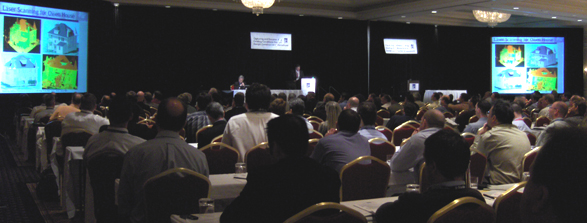The atmosphere at last week’s SPAR 2007 conference in Sugar Land, Texas was electric. Attendance increased more than 40% year-over-year to 575 attendees – this strong growth testifies both to surging demand for dimensional control and 3D capture solutions that yield demonstrable productivity and safety benefits to design, construction and management of capital assets, and to a rich pipeline of innovative products and solutions. Attendees from organizations as diverse as Atomic Energy of Canada, BP, the General Services Administration, Northrop Grumman Ship Systems, the US Army, the FBI, the NYPD, family-owned surveyor firms, civil and transportation engineering firms, dimensional control specialists and state DOTs found common ground – the exchange of ideas continued long after the formal program adjourned.
Keynotes by Doug Eberhard, CTO of Parsons Brinckerhoff, Deborah Deats, Design and Document Team Leader at BP Texas City, and Martin Fischer, Director of Stanford’s CIFE (Center for Integrated Facility Engineering), focused on how these technologies are improving refurbishment of civil and transportation infrastructure, aiding new capital projects, asset management and operational safety in oil and gas, and making construction more efficient and accurate by connecting virtual models with the real world.
Construction applications explode
Advanced dimensional control and position measurement have broken out of the engineering department. Construction schedules and asset management productivity in many instances depend on reliable dimensional and position information – it’s no longer seen as nice to have, but a must. Fabricating and constructing offshore surface and subsea installations, refurbishing nuclear plants, repairing battle-damaged ships, driving fleets of automated grading machines from multi-sensor construction site data, monitoring construction progress and quality in real time – case after case showed these tools and work processes being used to improve fabrication and construction.
Dynamic survey takes off
Dynamic survey – scanning on the move from a helicopter, fixed-wing aircraft, ground vehicle, rail car or boat – saw a sharp uptick in activity and in technology development. Attendees learned about new technologies for fusing data from 3D laser scanners, GPS/RTK, inertial measurement, video, traditional survey, laser bathymetry, even GPR. Surveying from the air to avoid contaminated or hazardous environments, using rotary-wing LIDAR to deliver engineering-grade data at planning-grade cost and schedule, new truck-mounted multi-sensor arrays to efficiently document long highway corridors, bathymetric monitoring of coastal erosion – attendees learned about all this and more.
Asset management is here
Asset management, long talked about as potentially the largest-payback application of validated 3D dimension and position information, is here. This year attendees saw practical examples from oil and gas, coke processing, DOTs, shipbuilding, more. There are still hurdles to overcome in managing very large data sets, synchronizing change, and communicating this information in web-based environments. But it’s clear there’s a strong case for asset management grounded in as-found 3D geometry.
Historic preservation
A keynote by Ben Kacyra, cofounder of CyArk and Cyra Technologies, and multiple presentations by service providers vividly displayed the value of 3D data capture in documenting, preserving and restoring historic monuments and cultural heritage sites in Bavaria, China, Israel and elsewhere.
Forensic & Security Metrology 2007
FSM 2007, a new conference co-located with SPAR 2007 and dedicated to forensic and security applications of 3D measurement, drew law enforcement, investigative and security professionals from federal, state and local governments in the U.S., Canada, the U.K., Germany, Switzerland, The Netherlands and Taiwan.
Continued
Wealth of new technologies from 24 sponsors
Attendees saw a wealth of new products and technologies from the conference’s exhibitors. SPAR 2007 had eight first-time sponsors – Autodesk, Avatech, Blom Maritime, COADE, DCMS, InteliSum, NavisWorks, Topcon – plus 16 returning from last year: AVEVA, Basis Software, Bentley, FARO, Grenland AsIs, Hi-Cad, INOVx, Intergraph PPM, I-SiTE, kubit, Leica Geosystems HDS, METCO Services, Optech, Riegl USA, Trimble and Z+F.
Here’s a brief digest of some product announcements from the conference – we’ll report more details of sponsors’ rich technical content in coming weeks.
Optech unveiled a lower-cost version of its ILRIS-3D terrestrial laser scanner called ILRIS-3DVP (Value Package). We understand the new offering will be priced starting under $70,000, compared with just under $100,000 for ILRIS-3D. Based on the same technology as its big brother, ILRIS-3DVP has the same range, resolution and other capabilities, but omits the built-in display, internal high-resolution digital camera, wireless connectivity, Motion Compensation option and Extended Range option of ILRIS-3D.
INOVx added new support for laser scan data in its RealityLINx version 5.0 software, and expanded the software’s links to plant design systems. RealityLINx Exchange is a new module for serving up FARO scan data to AVEVA PDMS, Intergraph PDS, AutoCAD, Bentley MicroStation and other CAD and plant design systems. Also new is an alliance between AVEVA and INOVx to integrate RealityLINx Exchange with AVEVA PDMS using AVEVA Laser Model Interface. In the data exchange area, INOVx agreed to transfer its technology for writing Intergraph PDS models to Noumenon Consulting, which in return will provide its XMpLant software for INOVx to embed in RealityLINx. XMpLant is interoperability technology using ISO 15926 that has been adopted by major plant design software vendors including AVEVA and Bentley for converting models from PDS to PDMS and publishing models to AVEVA’s VNET.
FARO showed FARO Scene v4.1, a new software version designed to reduce on-site scanning time and let users process and present results more effectively. V4.1 has a new Wi-Fi/WLAN Scanner Connection that lets users control scanning from a PDA, mobile phone, laptop or other Internet Explorer-equipped handheld device, instead of a bulky laptop. A new Draw-to-CAD feature lets users create 3D AutoCAD drawings on the fly by sketching lines in FARO Scene’s Photo-View. Color 3D laser scanning was also upgraded – color capture is more than 86% faster than previously (2-3 minutes versus 15 minutes before) for automatic overlays of 50 million color pixels. And a new Super Mobile Laser Scanner Kit eases carrying the LS to construction sites, forensic engagements and the like – it includes a carbon-fiber tripod, Wi-Fi/WLAN scanner connection, scanner-based web server, and rucksack.
Just before the conference, Hi-Cad won a contract to provide dimensional control management on the Shell Perdido Regional Host Truss Spar Platform (GoM – Alaminos Canyon 857) which will service the Great White, Tobago and Silvertip discoveries. The spar will be built in Technip’s yard in Pori, Finland and the topsides will be constructed in Kiewit’s yard in Ingleside, Texas. Perdido Regional Host will be installed in 7,817 feet (2383m) of water, which will make it the deepest-water spar development to date. The topsides will be lifted onto the hull in a single 9,500-ton lift by Heerema Marine Contractors.






